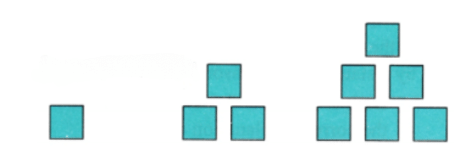Unit Test: Patterns in Mathematics | Mathematics for Class 6 PDF Download
Time: 1 hour
Maximum Marks: 30
Attempt all questions.
Question numbers 1 to 5 carry 1 mark each.
Question numbers 6 to 8 carry 2 marks each.
Question numbers 9 to 11 carry 3 marks each.
Question number 12 & 13 carry 5 marks each.
Q1: What is the next number in the sequence: 1, 4, 9, 16, 25? (1 Mark)
Q2: Find the sum of the first 10 triangular numbers. (1 Mark)
Q3: If you add up the first 6 odd numbers, what square number do you get? (1 Mark)
Q4: Continue the pattern for the next three terms: 1, 2, 4, 8, ___ , ___ , ___. (1 Mark)
Q5: Which of the following is not a sequence of powers? (1 Mark)
(i) 1, 2, 4, 8, 16
(ii) 1, 3, 9, 27, 81
(iii) 1, 5, 25, 125, 625
(iv) 1, 3, 6, 10, 15
Q6:Visualise the square number 64. (2 Marks)
Q7:Visualize cube number 1000. (2 Marks)
Q8:What is hexagonal number? Represent it pictorially. (2 Marks)
Q9: Complete the following number sequences:(3 Marks)
(a) 1 + 3 + 5 + ___ + 9 + 11 = ____.
(b) 1 + ___ + 3 + 4 + 3 + 2 + 1 = ____.
(c) 1 + 2 + 3 + __ + 5 + __ + 7 +…..+ 11 + __+ …. + 7 + ___ + 5 + 4 + 3 + 2 + 1 = 121
Q10: Identify the patterns and write the next three numbers to complete the given patterns.(3 Marks)
(a) 1, 3, 6, 10, 15, ….., …., ….
(b) 1, 4, 9, 16, 25, …, …, ….
(c) 1, 8, 27, 64, 125, …, …, ….
Q11:(i) Assertion: 15 is both a triangular number and a square number. (3 Marks)
Reason: If dots arrangement of a number is represented in triangle as well as in square, then the number is called both triangular as well as square number or square- triangular number.
In the given question, a statement of Assertion is followed by a statement of Reason. Choose the correct option as:
(a) Both assertion and reason arp true and the reason is the correct explanation of assertion.
(b) Both assertion and reason are true but the reason is not the correct explanation of the assertion.
(c) Assertion is true and the reason is false.
(d) Assertion is false and the reason is true.
(ii) Given the sequence 1, 3, 6, 10, 15, find the sum of the next two terms.
Q12: Represent first 7 centered hexagonal numbers pictorially. (5 Marks)
Q13: Case Based Question (5 Marks)
Rima and Diva are playing with square counters.
Rima arranges her counters as follows:

Diva arranges the counters as follows:
 One of their friends, Rohan, says these are showing the number patterns.
One of their friends, Rohan, says these are showing the number patterns.
Based on the above information, answer the following questions.
(a) What are the number patterns they are showing?
(b) If Rima’s arrangement is representing the triangular numbers, then what will be her next two arrangements if she follows the same pattern?
(c) What is Diva’s next arrangement with counters if she follows the same pattern?
You can find the solutions of this Unit Test here: Unit Test (Solution): Patterns in Mathematics
|
48 videos|334 docs|23 tests
|
FAQs on Unit Test: Patterns in Mathematics - Mathematics for Class 6
| 1. What are some common patterns found in mathematics? |  |
| 2. How can recognizing mathematical patterns improve problem-solving skills? |  |
| 3. What hobbies can help enhance mathematical pattern recognition? |  |
| 4. Are there specific mathematical patterns that are more relevant to certain hobbies? |  |
| 5. How can teachers incorporate pattern recognition in math education? |  |






















